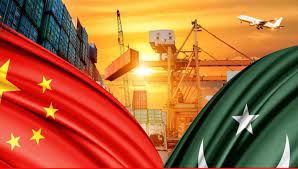CPEC decade – A voyage to new development heights

Islamabad: Known as the ‘iron brothers,’ Pakistan and China resolutely reinforced their commitment to bolstering regional connectivity and economic prosperity through a decade-long struggle to elevate China Pakistan Economic Corridor (CPEC) to unprecedented levels.
It was ten years back, when two all-weather friends solidified their commitment by signing a multibillion-dollar CPEC Framework Agreement, marking a significant milestone in their collaborative efforts, official media reported.
China boldly stepped forward, when other countries hesitated to invest in Pakistan, pledging an initial investment of US$46 billion that later expanded to a substantial sum of US$62 billion.
Now the two countries are celebrating 10 years of undeterred bilateral cooperation with a renewed pledge to move forward at a faster pace towards the CPEC’s ultimate destination of regional progress and prosperity.
On July 11, a meeting of the 12th (Special) Joint Cooperation Committee (JCC) was held in Beijing, co-chaired by Minister for Planning, Development and Special Initiatives, Professor Ahsan Iqbal and Vice Chairman, National Development and Reform Commission (NDRC) China, Cong Liang.
During the meeting, the minister said the CPEC was a remarkable endeavor that symbolized the deep-rooted ties between China and Pakistan.
“It has fostered connectivity, enhanced trade and opened up new avenues for shared prosperity,” Ahsan Iqbal said.
“CPEC is the topmost priority of Pakistan-China All-Weather Strategic Cooperative Partnership as these avenues provided an opportunity to consolidate successes and enhance future cooperation.”
He recalled that monumental event when visionary leaders President Xi and Prime Minister of Pakistan Muhammad Nawaz Sharif had launched this project aimed at transforming the region’s economic landscape.
According to a senior official of the Chinese Foreign Ministry, the CPEC projects, under the Belt and Road Initiative (BRI), were flourishing all across Pakistan and had attracted US$25.4 billion in direct investment from China during the last 10 years.
“After ten years of development, a “1+4″ cooperation layout has been formed, with the CPEC at the centre and Gwadar Port, transport infrastructure, energy and industrial cooperation being the four key areas,” the official said.
The CPEC framework has created 192,000 jobs, producing 6,000 megawatts of electric power, building 510 kilometers of highways and adding 886 kilometers to the core national transmission network, he added.
The CPEC has made a tangible contribution to Pakistan’s development and connectivity in the region. China and Pakistan have also explored new areas for cooperation under the CPEC framework by focusing areas like agriculture, science and technology, telecommunication and people’s well-being.
“China stands ready to work with Pakistan to build on the past achievements and follow the guidance of the important common understandings between leaders of the two countries on promoting high-quality development of CPEC to boost the development of China and Pakistan and the region and bring more benefits to people of all countries,” the official said.
Prime Minister Muhammad Shehbaz Sharif, during a recent meeting with Chinese Charge d’affaires Pang Chunxue has also reiterated that as ‘Iron Brothers’ and old friends, Pakistan and China always stood firm against all odds and enjoyed unflinching bilateral support on issues of mutual concern.
Noting the upward trajectory in Pakistan-China ties and economic and financial cooperation, the Prime Minister eulogized China’s support for Pakistan’s economic stability and expressed a firm commitment to further strengthen the relationship between the two countries under the rubric of the Global Development Initiative and CPEC.
“Implementing multi-billion-dollar development projects under the CPEC has brought socio-economic benefits to Pakistan and helped our country progress in the region and beyond,” the Prime Minister said addressing a ceremony to mark a decade of the signing of CPEC.
It is worth mentioning that during the last fiscal year, projects to supply gas to CPEC’s Special Economic Zones (SEZs) have been completed. Besides the financial year 2022-23, over 15 mega projects related to the development of Gwadar deep seaport, an ultimate destination of the CPEC, had been completed.
The completed mega projects include a 300 MW coal power plant, 2000 boat engines, Khuzdar to Panjgur transmission line, Gwadar International Airport, Pak-China Technology Institute, Gwadar Hospital, Smart Port and certain other projects. The construction of a modern hospital in Gwadar would ensure the best healthcare facilities for the local people.
The CPEC project made remarkable progress in its first phase (2015-2020), especially in the early harvest period (2013-18) whereby several mega projects have been completed including KKH Phase-II (Havelian-Thakot Section).
The second phase (2021-25) with a focus on industrialization, agriculture modernization, socio-economic development and cooperation in Science and Information Technologies (SITs) has already taken off aims at reaping the dividends of investment made in energy and transport infrastructure.
However, other avenues of cooperation defined in the CPEC-Long-Term Plan (2015-30) are being opened to progress tourism, mines and minerals and petroleum sectors in the second phase.
As the CPEC moves closer to fruition, its positive impact will extend beyond the borders of China and Pakistan. The project holds the potential to transform the entire region, fostering economic growth and creating new opportunities for Iran, Afghanistan, Central Asian Republics, and beyond.
The CPEC decade stands as a testament to the power of cooperation and the “iron brothers” determination to forge a path towards shared progress and prosperity.





